पपीते के चार प्रमुख रोग और उनका प्रबंधन
1. Foot Rot of papaya (Pythium aphanidermatum)
Foot rot is also known as collars rot or stem rot or root rot and damping off ; is the most serious disease of papaya. In India, the disease appears during the rainy season. It is more common in trees of age 2-3 years.
Symptoms
- In case of nursery plants, damping off symptoms are produced, whereas in adult plants foot rot, collar rot symptoms are produced.
- Foot rot is characterized by the appearance of water soaked patches on the stem near ground level.
- These patches enlarge rapidly and girdle the stem, causing rotting of the tissues, which then turn dark brown or black
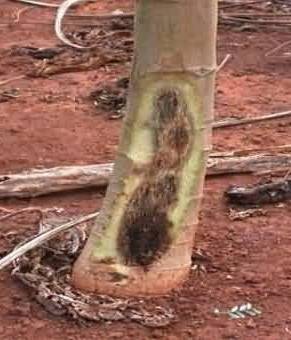
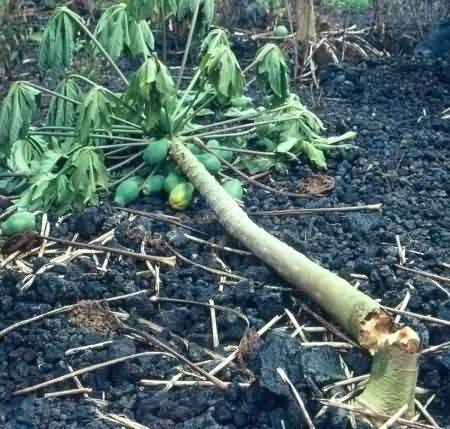
Pathogen
- Causal organism: Pythium aphanidermatum
- Mycelium is aseptate, brown and much branched.
- Sporangia vesicle formed at the time of germination, zoospores 30-40 in number present within the vesicle and are born on spherical Oogonia.
- They germinate by producing a germ tube.
- The sexual spores are the oospores, born singly and moderately thick walled.
Disease cycle:
The pathogen is soil inhabitant and is capable of growing and surviving on the residue left in the soil where it produces abundant oospores in the decaying organic matter.
Survival and spread :-
Primary infection: Oospores (Pythium) in soil
Secondary infection : Zoospore and Seedlings raised in infected soil carry the disease to field
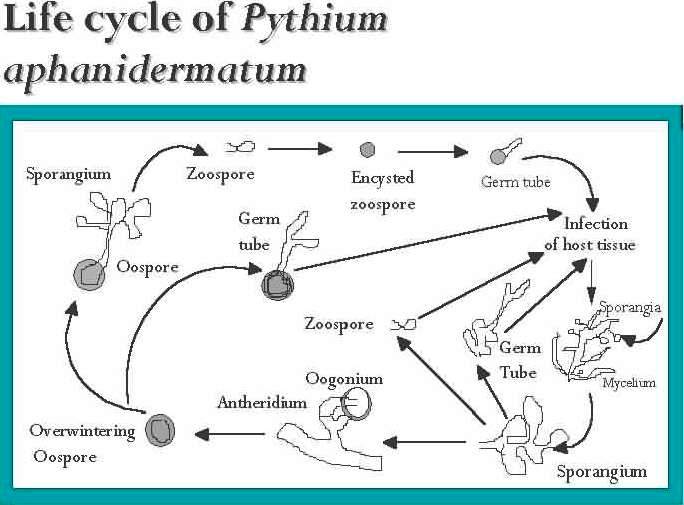
Favourable conditions
- Appears from June to August
- Younger seedlings are more susceptible than older ones
- Severity increases with intensity of rainfall
- it is severe in dry and hot weather (360 C).
- Common in 2-3 year old trees.
Management
- Seed treatment with Thiram or Captan 4 g/kg or Chlorothalonil.
- Drenching with Copper oxychloride 0.25 % or Bordeaux mixture 1% or Metalaxyl 0.1%.
- Seedlings should be raised in well drained nursery are
- Uproot the diseased seedlings and burn
- ST with captan@4g/kg seed or chlorothalonil@2g/kg seed (R. solani)
2. Leaf Curl Disease of Papaya:
- It is caused by Papaya leaf curl virus
- The disease is transmitted by the vector white fly (Bemisia tabaci).
SYMPTOM
- Curling, crinkling and distortion of leaves, reduction of leaf lamina, rolling of leaf margins inward and downward, thickening of veins.
- Leaves become leathery, brittle and distorted. Plants stunted.
- Affected plants does not produce flowers and fruits.
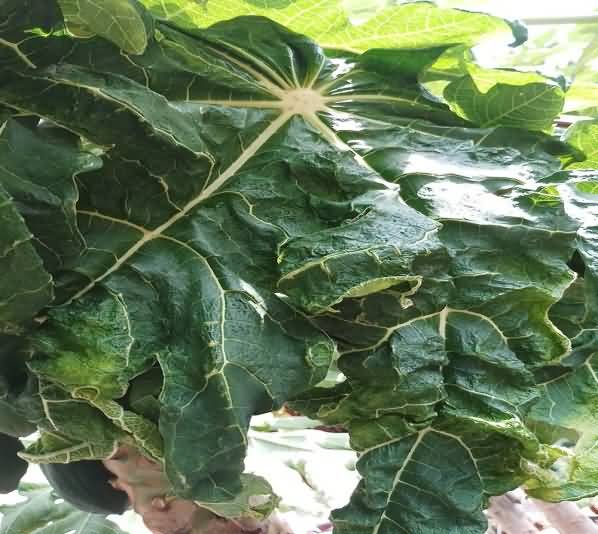
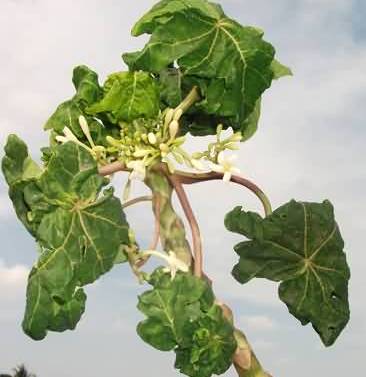
Survival and spread
- Infected plant parts
- Whitefly, Bamesia tabaci and grafting Virus also infects tobacco, tomato, sun hemp, chilli, Petunia, Zinnia, Datura stramonium, hollyhock, cape gooseberry etc.
Management
- Disease free seedlings
- Rouging and destruction of diseased plants
- Vector control with
This email address is being protected from spambots. You need JavaScript enabled to view it. % or Dimethoate@0.2% or metasystox@0.1% - Uproot affected plants.
- Avoid growing tomato, tobacco near papaya. Spraying with systemic insecticides to control
3. Papaya Ring spot Virus Disease
It is caused by Papaya ring spot virus
Symptoms:-
- Vein clearing, puckering and chlorophyll leaf tissues lobbing in.
- Margin and distal parts of leaves roll downward and inwards, mosaic mottling, dark green blisters, leaf distortion which result in shoe string system and stunting of plants.
- On fruits circular concentric rings are produced. If affected earlier no fruit formation.
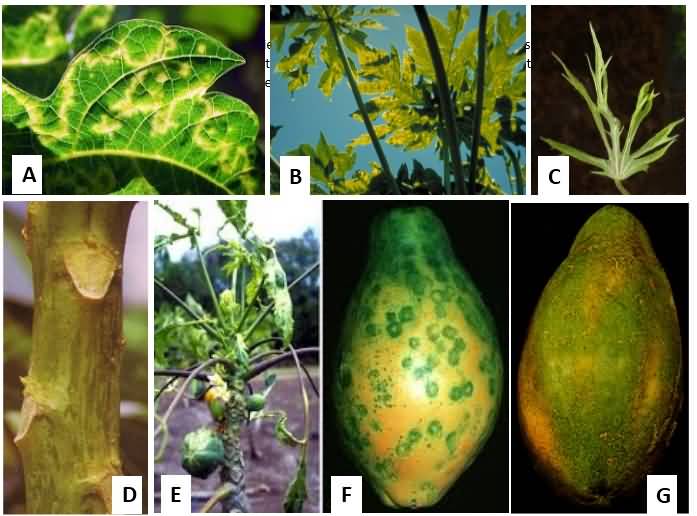
Pathogen
- The virus particles are rod shaped and thermal inactivation point of the virus lies between 54 and 60˚C.
- Mode of spread Vectored by aphids Aphis gossypii, A. craccivora and also spreads to cucurbits not through seeds.
Management
- Raise papaya seedlings under insect-proof conditions.
- Plant disease free seedlings.
- Raise sorghum / maize as barrier crop before planting papaya.
- Rogue out affected plants immediately on noticing symptoms.
- Do not raise cucurbits around the field.
4. Root knot of papaya
Causal organism: Meloidogyne incognita
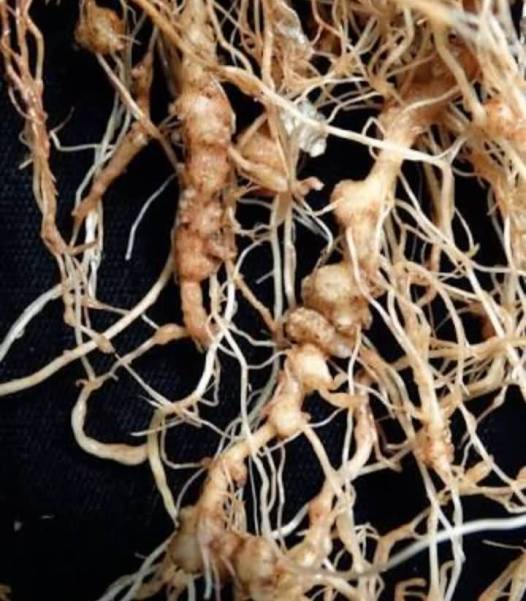 Symptoms:-
Symptoms:-
- Formation of galls on host root system is the primary symptom
- Roots branch profusely starting from the gall tissue causing a ‘beard root’ symptom.
- Gradual yellowing of plant
- stunting,
- root discoloration,
- formation of knots on the roots,
- root decay and finally plant collapse, are the major symptoms
Mode of spread and Survival
- Juveniles and eggs survive periods of moisture stress in a state of anhydrobiosis.
- Irrigation water and soil adhering to animal feet and implements help in dissemination of juveniles and eggs of nematodes
Management
- Crop rotation with graminaceous hosts.
- Inclusion of non-preferred hosts like mustard, sesame, maize, wheat, etc., in the cropping system.
- Intercropping of marigold reduces nematode population.
- Nursery should be raised in nematode free sites or fumigated beds.
- Deep ploughing of infested fields during summer.
- Three summer ploughings at 10 days interval reduces juvenile population .
- Flooding the field for prolonged periods.
- Use of biocontrol agents like Paecilomyces lilacinus (egg parasite).
- Nursery bed treatment with metham sodium (Vapam)@25ml/m2 or
This email address is being protected from spambots. You need JavaScript enabled to view it. a.i/m2 . - Bare root dip treatment in EC formulation of systemic pesticides like Dimethoate or Phenemiphos for 6-8 hours before transplantation
Authors
Pinki Devi Yadav, Madhu Kumari, Maya Meena, Sonu Meena
Sri Karan Narendra Agriculture University, Jobner
Email:
